Are you curious about the most snake-infested areas in Canada? Then you’re in the right spot. This article focuses on where snakes are slithering around, looking at various habitats ranging from forests to lakes. One snake hot spot has 70,000 snakes emerging from hibernation every year. Can you imagine what that’d look like? Snakes are a fascinating, often misunderstood species. Let’s dive into the truth about what they’re all about as we learn all about places in Canada to see snakes.

1. Eastern Side of Georgian Bay and the Bruce Peninsula
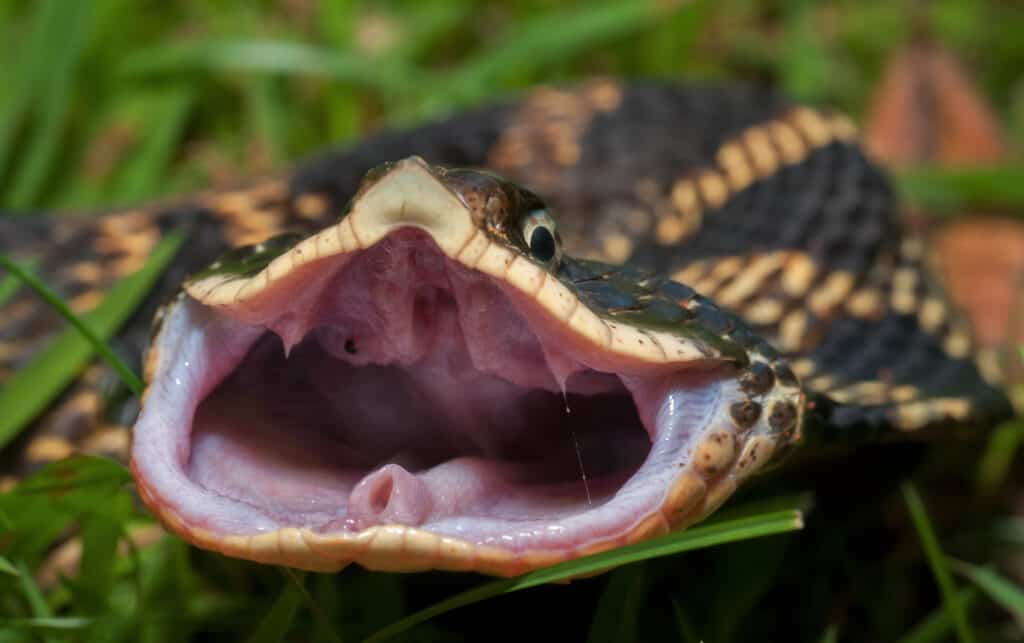
You can find eastern hognose snakes throughout the Bruce Peninsula; their upturned nose earns their name.
©Mike Wilhelm/Shutterstock.com
The eastern massasauga, the deadliest snake in Canada, is on the eastern side of Georgian Bay and the Bruce Peninsula. This rattlesnake, exclusive to Ontario, Canada, has claimed two reported deaths, making it the deadliest snake in the country. You can find small populations of eastern Massasauga rattlesnakes along the eastern shore of Georgian Bay, certain areas of the Bruce Peninsula, the Niagara Peninsula, and near Windsor. These rattlesnakes are considered medium-sized, measuring 24 and 30 inches long. Coloration can vary, but they’re usually tan or gray, with dark blotches down their back. They also have three smaller blotches on their sides.
Eastern Hognose Snake
Eastern hognose snakes in Canada have a limited distribution, with less than 10% of their global range occurring in the country. They are found in two geographically distinct regions: the Carolinian Region of southwestern Ontario and the Shield region of central Ontario, south of the French River and Lake Nipissing and east of Georgian Bay. These snakes love eating toads, so you’ll only find them in toad-rich environments. They also prefer sandy, well-drained areas like beaches and dry forests, where they can lay eggs and hibernate. For reproduction, they use their upturned snouts to dig burrows below the frost line in the sand, where they deposit their eggs.
The most noticeable feature of the eastern hognose snake is its upturned pig-like nose, which gives it its name. When feeling threatened, they exhibit various behavioral displays, including coiling up and flattening their heads and necks to form a cobra-like hood, inflating their bodies to appear larger, hissing loudly, and striking with a closed mouth to appear more aggressive. If these displays fail to deter predators or humans, the snake may roll over and play dead as a final defense strategy.
2. Thompson and Okanagan Valleys
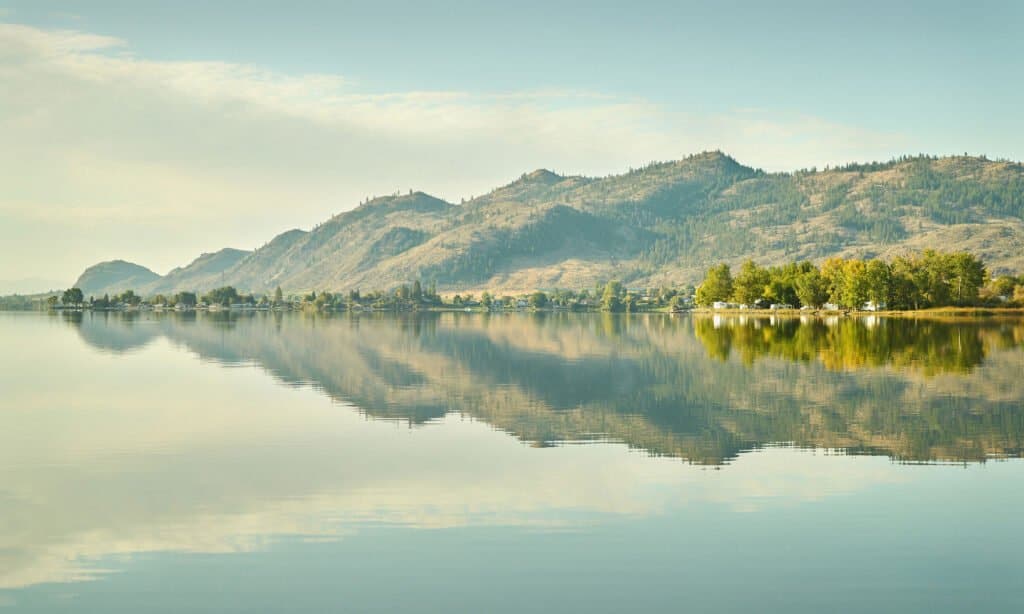
The land surrounding Osoyoos Lake in the Okanagan Valley is home to the Northern Pacific Rattlesnake.
©iStock.com/Maxvis
The Thompson-Okanagan region in the southern interior of British Columbia provides the perfect environment for fascinating snake species. This diverse area has tall mountains, rolling hills, raging rivers, peaceful lakes, a desert, and even a temperate rainforest. Major cities such as Kelowna, Kamloops, Vernon, and Merritt are part of this snake-active region.
Northern Pacific Rattlesnake
One of the most well-known snakes in the area is the Northern Pacific rattlesnake or western rattlesnake. These rattlesnakes inhabit mountain valleys in British Columbia; they’re the only rattlesnake species in the province. They can grow just over one 3 feet and weigh nearly 2 pounds. Their coloration ranges from olive-green to tan, adorned with dark blotches along their backs. The distinctive rattlesnake tail has alternating dark and light bands and ends with a rattle in adult individuals. Rattlesnakes overwinter in communal dens with other snake species, usually in southwest-facing talus slopes and rock slides. Daily habitats include open forests, riparian areas, sagebrush, and antelope brush in shrub-steppe areas.
Night Snake
The desert night snake lives in the south Okanagan and lower Similkameen valleys of British Columbia, Canada. It holds the distinction of being the rarest snake species in Canada. Interestingly, female desert night snakes exhibit sexual dimorphism, being 50% longer than males and having triple the body mass. These highly adaptable snakes live in rocky grassland areas, desert scrub, thorn scrub, mountain meadows, and woodlands. They possess a remarkable ability to conceal themselves by seeking shelter under leaf piles and rocks.
Being primarily nocturnal, it’s not likely you’ll see a night snake. Since they are so elusive, there’s little known about this snake’s reproductive behaviors. We know they’re oviparous, with females laying two to nine eggs.
Finally, the species is mildly venomous, using its venom to capture and consume small reptiles, mammals, and amphibians. The venom isn’t harmful to humans. Unlike rattlesnakes, the night snake doesn’t have a rattle. However, when threatened, it can mimic rattlesnake behavior by flattening its head and coiling its body for self-defense.
3. Fraser River Valley
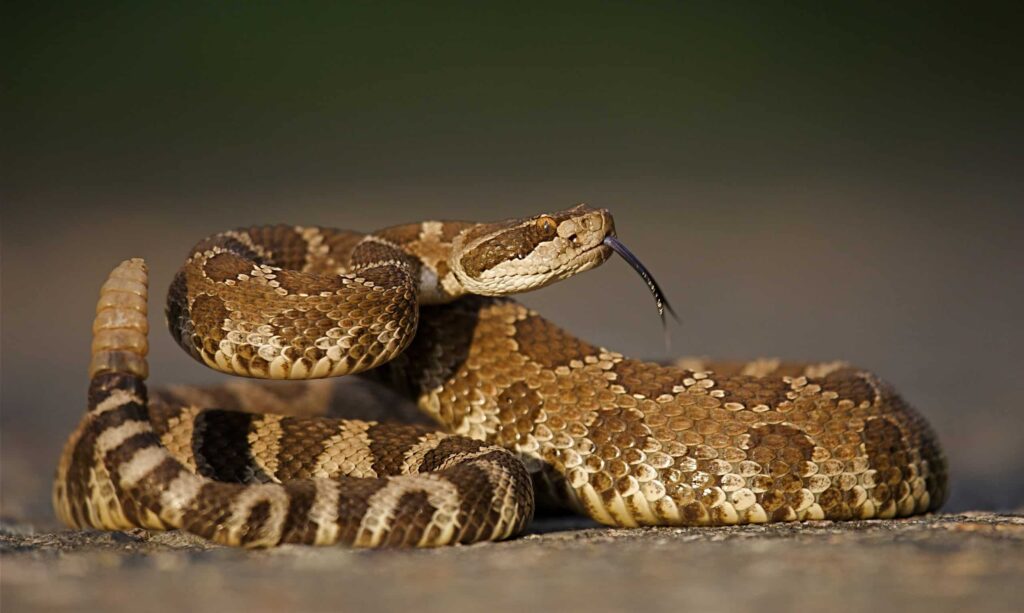
The western rattlesnake lives in British Columbia, a common species throughout the Fraser River Valley.
©Tom Reichner/Shutterstock.com
Stretching from Lillooet north to Big Bar Creek, the Fraser River Valley, a region in the dry southern interior of British Columbia, harbors the excellent basin gopher snake. The great basin gopher snake can display several behaviors when annoyed or threatened. If agitated, it may flatten its head and start hissing. The flat head gives the snake a more intimidating appearance. They’ll also vibrate their tail to warn predators to stay away.
Fraser River Valley is a prime habitat for these snakes, but there are other places you’ll find them in Canada. The gopher snake’s range covers various scenic valleys, including those of the Thompson, Okanagan, Similkameen, Kettle Creek, and Nicola. Their habitat also includes the warm and arid grassland valleys of the Thompson and Okanagan Rivers. This snake occupies elevations ranging from 656 feet to 3280 feet throughout most of its Canadian range, with occasional sightings at elevations up to 5,577 feet.
Western Rattlesnake
Only occurring in British Columbia, western rattlesnakes are venomous and can grow to about 3 feet long. Often confused with gopher snakes, this rattler puffs itself up to appear larger when there’s a threat; other times, they’ll try to hide. For most of the year, the western rattlesnake likes to slumber in hibernation, only becoming active from April through October.
Rubber Boa
The Thompson-Okanagan region is also home to the rubber boa. It’s the most northerly boa species in the world, and they look like a giant worm. One of the reasons they look like worms has to do with the lack of a defined neck. These small worm-like snakes also have blunt tails, which closely resemble their heads, leading to the nickname “Two-Headed Snake.” Closely related to anacondas and boa constrictors, this snake is much smaller, growing to about as long as 2.5 feet long. This elusive species prefers to remain hidden and is rarely encountered, even by seasoned researchers.
4. Lake Erie and Lake Huron

Various snakes live along the Great Lakes, including eastern fox snakes and ribbon snakes.
©iStock.com/PeterHermesFurian
What about all of the snakes in Canada’s lakes? Snakes are not just creatures of the land; some species have adapted to the semi-aquatic lifestyle, thriving in land and water habitats. Let’s look at some of the snake species found around the shorelines of Lake Erie and Lake Huron.
- Kirtland’s Snake
- Common Ribbonsnake
- Northern Watersnake
- Common Watersnake
- Lake Erie Watersnake
- Eastern Fox Snake
Kirtland’s snakes are one of the smaller snakes swimming around Lake Erie and Lake Huron, with a total adult length ranging from 14 to 24.5 inches. They might be one of the daintiest snakes, but they’re also quite dramatic. If there’s a threat, these snakes put on quite a show. They might writhe around or take it to the next level by rolling into a ball and pretending to be lifeless.
As for coloration, Kirtland’s snakes sport a reddish to dark brown hue and display four rows of alternating dark, round blotches along the back and sides. The real showstopper is its belly, which can be vibrant red, orange, or pink.
Eastern Fox Snake
Meet one of Ontario’s most giant snakes—the eastern fox snake, a lengthy species that can grow up to 5.5 feet long. These giant snakes are easy to spot with their shiny, rusty orange head and golden to light brown bodies adorned with dark blotches. The belly is a distinctive combination of light yellow and black. These snakes are also excellent swimmers, capable of traveling long distances over open offshore waters and between islands.
Eastern fox snakes are mainly an open wetland species. They live along Great Lakes shorelines, sticking to areas with plenty of plants to provide cover and hunting grounds. Along with their marine habitat, these snakes also venture into drier areas, like beaches.
As for their activity period, these snakes remain active from the third week of April to the fourth week of October. During the first week of June to the second week of July, it’s time for romance as breeding occurs. As summer peaks, nesting occurs from the fourth week of June to the fourth week of July. Regarding nesting and hibernation, eastern fox snakes display resourceful behavior. They deposit their eggs in or under various locations, including the soil and mammal burrows. During hibernation, they find cozy spots in abandoned mammal burrows and sometimes muskrat lodges.
5. Lake Ontario

The gray rat snake is the biggest snake species in Canada; it enjoys living around Lake Ontario.
©Jay Ondreicka/Shutterstock.com
There are a few different snake species to learn about that live around Lake Ontario. The Massasauga rattlesnake is the only venomous snake in the region. However, it’s not aggressive and will usually run away instead of biting when it feels threatened. Other snake species found in Ontario include rat or milk snakes, eastern garter snakes, gray rat snakes, northern watersnakes, and Lake Erie watersnakes.
Gray Rat Snake
The largest snake in Canada is the gray rat species hanging out along Lake Erie’s north shore and the eastern end of Lake Ontario. They live in woodland habitats using rock crevices, hollow logs, and standing snags from the active seasons from May to September. When they’re active, their diet consists of rodents, frogs, lizards, and small birds, making them strict carnivores that exclusively eat other animals. They exhibit different feeding behaviors depending on their prey’s size, often swallowing small prey alive and constricting larger prey by coiling their bodies. Juvenile gray rat snakes, in particular, prefer to feed on Canada’s lizards and frogs.
When the cold comes, and it’s time to hibernate, they go into a hibernacula underground. A hibernacula is a place where animals seek refuge, especially during the winter months, to go into hibernation or a state of torpor. It serves as a shelter that provides protection from harsh weather conditions and predators. Various animals use hibernacula for overwintering, including mammals like bears, bats, and rodents, as well as reptiles like snakes and lizards, and even insects and primates of different species.
Northern Watersnake
Another common snake around Lake Ontario is the northern watersnake. True to its name, it’s often found near water. If disturbed, this snake will escape into the water but can defend itself by releasing a smelly musk, flattening its body, and even striking if captured. Although not venomous, the northern watersnake can still deliver a painful bite. To identify them, look for their length, ranging from 24 to 55 inches, and their coloration varies from pale grey to dark brown with bands. Large adults can become darker with age, and females are generally larger than males.
6. Red River

There are a lot of garter snake species living around the Red River.
©iStock.com/rkhalil
The Red River, a major waterway in Manitoba, stretches roughly 550 miles. Its journey commences at the point where the Bois de Sioux and Otter Tail rivers merge, situated on the border between Minnesota and North Dakota. From there, it steadily flows northward, cutting through the southern regions of Manitoba, until it eventually pours into Lake Winnipeg. This river is a haven for various snake species, including water snakes, garter snakes, and eastern milk snakes. The river is also home to many fish species, such as channel catfish, muskellunge, northern pike, and smallmouth bass.
Common Garter Snake
The common garter snake is more elusive than common. These non-venomous snakes prefer hunting near marshes and ponds, where they prey on frogs, leeches, and occasionally small fish. They can grow up to about one meter long and 2.5 centimeters wide. When threatened, the garter snake releases a musky scent as a defensive mechanism.
Western Terrestrial Garter Snake
Often found along rivers and ponds, the western terrestrial garter snake is a great swimmer that feeds on fish and small mammals like mice. This snake also secretes musk for defense.
Red-Sided Garter Snakes
Female red-sided garter snakes typically give birth to live young in midsummer. A typical litter may consist of 10-30 baby snakes. These little ones take their time to mature, with a growth journey lasting two to three years before reaching adulthood. And as the red-sided garter snakes grow, their den preferences evolve.
In their first winter, most juvenile snakes seek refuge in ant hills, animal burrows, or crevasses below the frozen ground. As they mature, they migrate to established den sites. And they’ll return to these dens yearly, following scent trails to find their way home.
7. Narcisse Snake Dens in Manitoba
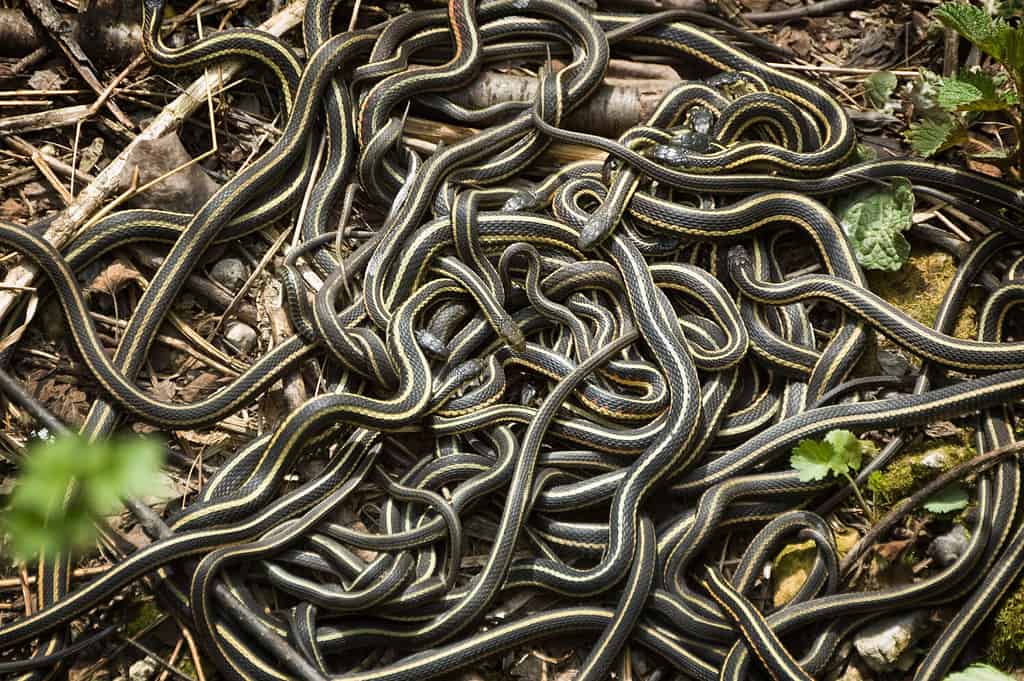
Thousands of red-sided garter snakes emerge yearly from hibernation for mating season.
©Cindy Creighton/Shutterstock.com
The Narcisse Snake Dens in Manitoba, Canada, is the place to be if you want to see thousands of snakes in one place. Every year, the red-sided garter snake emerges from hibernation, and it’s a show worth checking out. These slithery stars emerge from their cozy underground hibernation dens in astonishing numbers —we’re talking about 70,000 snakes. The moment they wake, they engage in a flurry of mating activities.
The Interlake region offers an abundance of food and water sources essential for their survival and reproduction. But it’s not just the surface that makes this place so special. Below ground, winter dens in the limestone bedrock are a game-changer. The snakes gather below the frost line, huddling together for warmth, skillfully surviving the harsh Manitoba winters. Over millennia, water eroded and collapsed the limestone, creating a complex network of crevasses and caverns extending to the earth’s surface. In this subterranean paradise, red-sided garter snakes find refuge, even taking shelter in limestone sinkholes that offer cozy protection from the extreme cold. Sinkholes the size of a living room become dens for tens of thousands of snakes.
When can you see the garter snakes emerge from hibernation? For an unforgettable springtime experience, head to the Narcisse Snake Dens during the end of April and the first three weeks in May. The peak activity often coincides with the Mother’s Day weekend. During this period, the snakes are busy with their amorous pursuits, making them easily viewable for eager visitors like yourself. Then the fun continues into fall when the garter snakes return to their dens in early September. They remain active and visible until the cool, wet autumn weather drives them back underground. For the best fall viewing experience, be sure to pick warm, sunny days for your visit.
8. Dinosaur Provincial Park in Alberta
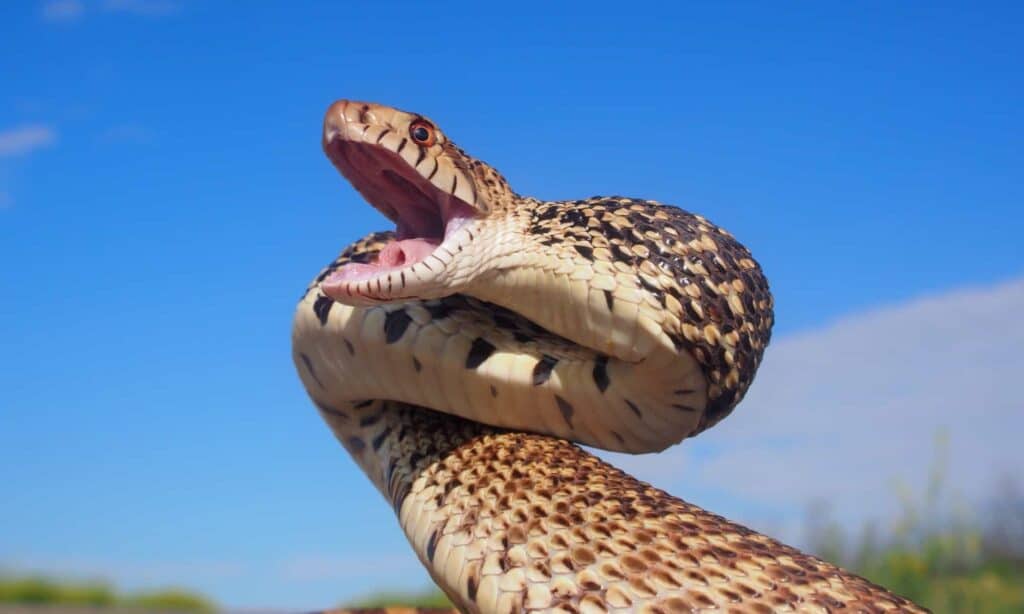
Bull snakes live throughout Alberta, Canada, and can be found in the Dinosaur Provincial Park.
©Markparker1983/Shutterstock.com
About 75 million years ago, during the late Cretaceous Period, Dinosaur Provincial Park in Canada featured a subtropical landscape with lush forests covering a coastal plain and rivers flowing east into a warm inland sea. The region was home to dinosaurs, flying reptiles, fish, turtles, crocodiles, and small mammals. The unique conditions preserved dinosaur bones as fossils, leading to the discovery of over 150 complete dinosaur skeletons after a century of excavations.
Today Dinosaur Provincial Park hosts diverse snake species, like prairie rattlesnakes, bull snakes, wandering, and plains garter snakes. The prairie rattlesnake is Alberta’s only venomous snake. Visitors are advised to stay vigilant and listen for the distinctive buzzing sound of their rattles. Sticking to established trails helps spot snakes sunning on the path. If you see one, avoid approaching and give them plenty of space.
Bull Snakes
Bull snakes big, bold, sociable snakes. These non-venomous constrictors are Alberta’s largest snakes and have a penchant for rodents. They’ll also eat young cottontails and nesting birds. Their secret weapon is an enlarged scale on their noses, which makes digging in loose soil or animal burrows easy.
Like their distant cousins, the rattlesnakes, these snakes put on a defensive display. They’ll hiss loudly and shake their tails. Yet, bull snakes are much more comfortable with human presence than rattlesnakes. They’re not your typical reclusive, shy type. Bull snakes don’t mind humans hanging around and watching their moves. You might even see one swing down from a tree to catch a snack. You can catch these snakes in various habitats, including fields, grasslands, forest edges, savannas, and brushlands. They’re not picky as long as the soil is sandy and the rodent population is plentiful.
Summary of 8 Places in Canada to See Snakes
Now you know a few of the best places to visit in Canada to see snakes.
| Rank | Places |
|---|---|
| 1 | Eastern Side of Georgian Bay and the Bruce Peninsula |
| 2 | Carolinian Region of Southwestern Ontario |
| 3 | Central Ontario |
| 4 | Thompson-Okanagan |
| 5 | British Columbia |
| 6 | Fraser River Valley |
| 7 | Lake Erie |
| 8 | Lake Huron |
| 9 | Lake Ontario |
| 10 | Red River |
| 11 | Narcisse Snake Dens in Manitoba |
| 12 | Dinosaur Provincial Park in Alberta |
Canada is home to roughly 26 native snake species, and only four can deliver a venomous bite. The eastern massasauga, prairie rattlesnake, desert night snake, and western rattlesnake. The other snake residents, like the gentle bull snakes, friendly garter snakes, and the northern watersnake, are completely nonvenomous. The good news is that snakes have no interest in targeting humans. They’re quite content with their natural prey and habitats.
The photo featured at the top of this post is © Cindy Creighton/Shutterstock.com
Thank you for reading! Have some feedback for us? Contact the AZ Animals editorial team.







